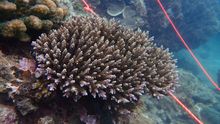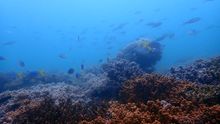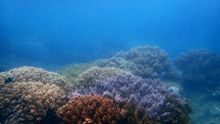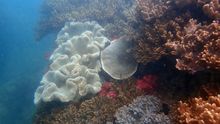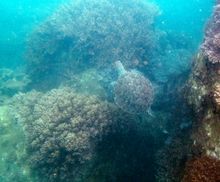 19 Oct 2024
19 Oct 2024
Tags: Zannier Hotels, Zannier Bãi San Hô, Sustainability, coral reefs, Vietnam

Zannier Bãi San Hô in Phu Yen is proud to announce a new partnership with SASA Marine Animals Rescue Center, aimed at ensuring the long-term protection and restoration of coral reefs along Vietnam's central coast. This collaboration highlights the resort's deep commitment to marine conservation, with a particular focus on preserving the unique coral bay that forms an integral part of its natural environment.
“This collaboration underscores our dedication to protecting the extraordinary marine ecosystems that surround us, showcasing the beauty of the reef to our guests and encouraging responsible tourism. At Zannier Bãi San Hô, sustainability is at the core of everything we do, and working with SASA allows us to take significant steps in safeguarding the region's coral reefs” said Alain Bachmann, General Manager of Zannier Bãi San Hô.
The first step of this collaboration involved conducting a comprehensive analysis of the underwater environment across the three reef areas within the resort's property, spanning approximately 63,000 square meters. This survey revealed that corals currently cover 60% of the reef areas, with 99% of these corals being soft corals, and only 1% consisting of reef-building corals. The scarcity of reef-building corals presents a challenge, as their colonies are young, small, and sparsely distributed. And this imbalance limits the reef's ability to regenerate and maintain its biodiversity. There is hope, however, as more than 40 species of reef-building corals have been identified (20 species of soft corals). These corals play a crucial role in forming the structural foundation of reefs, essential for their long-term resilience and biodiversity.
One of the urgent threats to the reef is the presence of Crown Of Thorns Starfish (COTS), an invasive species estimated at 100 individuals, that, if not controlled, could destroy the coral population within two years.
The collaboration aims to tackle these challenges with a comprehensive action plan designed to revitalize the bay, allowing guests to fully experience its extraordinary reef features, including reef cliffs, slopes, sea fan gardens, and caves across the three identified reef zones.
For this, the pluri-annual collaboration with SASA aims to gather crucial data on coral species, reef structure, and marine life to monitor the ecosystem's health and monitor an actionable restoration plan. This will involve reef cleaning, removal of invasive species, and replanting healthy reef-builder coral fragments to ensure a balanced and thriving ecosystem. In addition, a promotional video is considered to raise awareness about coral conservation and the importance of reef health.
As from fall 2024, Zannier Hotels and SASA will implement both physical and biological methods to manage the COTS population, including manual removal by experienced divers and the introduction of natural predators such as giant triton snails and titan triggerfish. This multi-pronged approach aims to stabilize the coral ecosystem and protect the reef in the long term.
"This partnership is a prime example of what can be achieved when we unite for a common goal – to preserve and restore the vital marine ecosystems while enriching guest experience" commented Mr. Chien Le, Founder of SASA. The joint efforts aim to not only protect the reefs but also enhance the snorkelling, underwater photography and freediving experiences that the resort offers, promoting sustainable tourism.
About Zannier Bãi San Hô
Zannier Bãi San Hô is a luxury resort located in the Phu Yen region of Central Vietnam, offering an immersive experience that blends natural beauty with cultural richness. Spanning 98 hectares of pristine coastal land, the resort is dedicated to sustainability and environmental stewardship, as evidenced by its Green Globe certification. Featuring 73 villas constructed with reclaimed wood and local materials, extensive solar energy use, and a commitment to preserving the surrounding ecosystems, Zannier Bãi San Hô provides guests with a unique and responsible luxury retreat. The resort also actively engages with local communities, promoting education, cultural heritage, and sustainable practices.
It hosts a beautiful bay featuring three coral reefs. The main reef, located on the north side of the bay, spans approximately 24,000 square meters and includes about 2,000 square meters of shallow reef
(1-2 meters deep), 2,000 square meters of reef slope (2-4 meters deep), and three notable reef cliff spots. Two additional rock reef areas extend over 14,000 and 25,000 square meters, further enriching the underwater landscape.
Commitment to sustainability
Zannier Bãi San Hô has already made significant strides in sustainability, implementing successful initiatives such as the installation of 655 solar panels to enhance energy efficiency, achieving a 30% reduction in energy consumption since 2022 through improved operational planning, the use of split-type AC units, and LED lighting. Additionally, the resort has completely eliminated single-use plastics from guest rooms and introduced a water filtration system. The resort also leads waste reduction efforts, by using eco-friendly materials and recycling 100% of its food waste. These ongoing practices complement the new coral reef conservation project, reinforcing the resort's role as a steward of the environment.
About SASA Marine Animals Rescue Center
Founded in 2018 by Chien Le, SASA Marine Animals Rescue Center is dedicated to rescuing stranded marine animals and restoring coral reefs across Vietnam. Through hands-on conservation efforts and community education, SASA plays a vital role in protecting the country's marine ecosystems. The organization's collaboration with Zannier Bãi San Hô further underscores its commitment to restoring the health of Vietnam's coastal waters.


